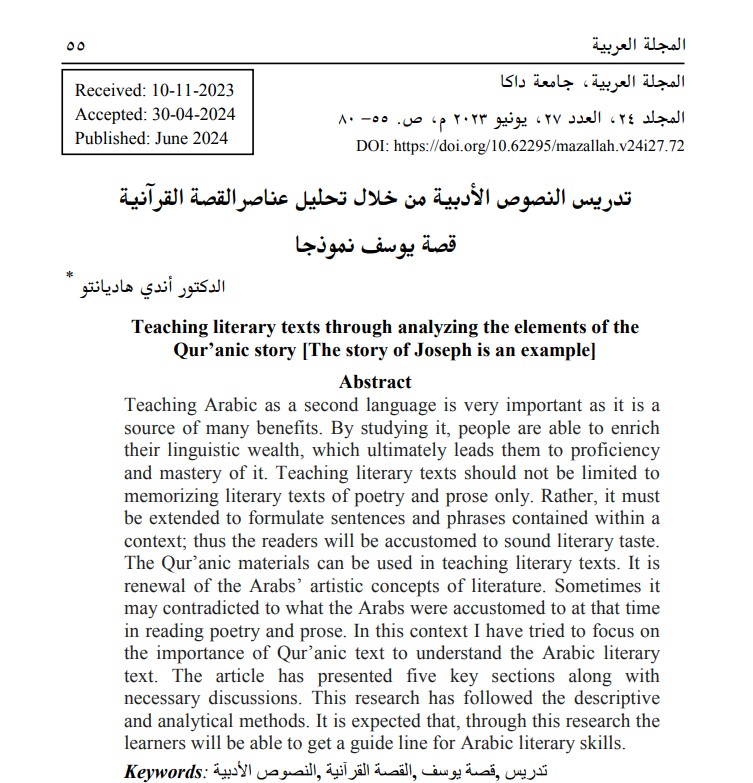Teaching literary texts through analyzing the elements of the Qur’anic story The story of Joseph is an example
النصوص الأدبية, القصة القرآنية, قصة يوسف, تدريس
DOI:
https://doi.org/10.62295/mazallah.v24i27.72Keywords:
النصوص الأدبية, القصة القرآنية, قصة يوسف, تدريسAbstract
Teaching Arabic as a second language is very important due to the great benefits it. By studying it, people are able to enrich their linguistic wealth, which ultimately leads them to proficiency and mastery of it. Teaching literary texts should not be limited to memorizing literary texts of poetry and prose only. Rather, it must extend to formulate sentences and phrases contained within a context and accustoming them to sound literary taste. The Qur’anic materials can be used in teaching literary texts. It is renewal of the Arabs artistic concepts of literature and what branches from it, because it contradicted what the Arabs were accustomed to at that time in poetry and prose, in addition to being one of the Qur’an’s means of conveying the call and establishing it in people’s understandings. In this context I have tried to focus on the importance of Qur’anic text to understand the Arabic literary text. The article has presented five key sections along with necessary discussions. This research has followed the descriptive and analytical methods. It is expected that, through this research the learners will be able to get a guide line for Arabic literary skills.
References
Abū Ṣāliḥ, ʻAbd al-Quddūs. 1114H. Al-balāghah wa-al-naqd. Saudi Arabia: Jāmiʻah al-Imām Saʻūd.
Al-ʻālam, Muḥammad Ghufrān Zayn. n.d. Al-balāghah fī ʻulūm al-Bayān. Jwntwr: Dār al-Salām.
Al-Najjār, ʻAbd al-Wahhāb. n.d. Qaṣaṣ al-anbiyāʼ. Beirut: Dār al-Fikr.
Al-Qaṭṭān, Mannāʻ. n.d. Mabāḥith fī ʻulūm al-Qurʼān. Beirut: Al-ʻAṣr al-ḥadīth.
Al-Ṣābūnī, ʻAlī. 1980. Al-Tibyān fī ʻulūm al-Qurʼān. Mecca: Maṭbaʻah Ḥasan ʻAbbās.
———. 1996. Ṣafwah al-tafāsīr. Beirut: Dār al-Fikr.
Al-Ṣīnī, Ismāʻīl Muṣṭafá. 1970. Al-Naqd al-Adabī wa-al-balāghah. Kuwait: Wizārah al-Tarbiyah.
Atar Semi, Muhammad. 1993. Tehnik Penelitian Sastra. Bandung: Angkasa.
Badawī, Aḥmad Aḥmad. n.d. Min Balāghah al-Qurʼān. Cairo: Dār al-Nahḍah.
Fayṣal, ʻAbd al-ʻAzīz Muḥammad. 1114H. Al-adab al-ʻArabī wa-tārīkhuhu. Saudi Arabia: Wizārah al-Taʻlīm al-ʻĀlī.
ʻAbd Al-ʻĀl, ʻAbd al-Munʻim Sayyid. n.d. Ṭuruq tadrīs al-lughah al-ʻArabīyah. Cairo: Maktabah Gharīb.
Qalyubi, Syihabuddin. 1997. Stilistika Al Qur’an. Yogyakarta: Titian Ilahi Press.
Quṭb, Sayyid. 1982. Al-Taṣwīr al-Fannī fī al-Qurʼān. Cairo: Dār al-Shurūq.
Rahmanto. 1999. Metode Pengajaran Sastra. Yogyakarta: Kanisius.
Sumarjo, Jakob. 1997. Apresiasi Sastra. Jakarta: Gramedia.
Ṭuʻaymah, Rushdī Aḥmad. 1989. Taʻlīm al-ʻArabīyah li-ghayr al-nāṭiqīn bi-hā. Rabat: Īsīskū.


